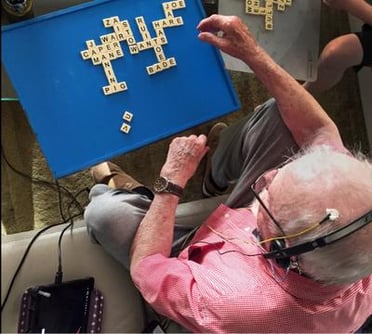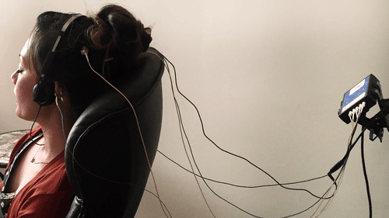BRAIN TRAINING
Brain training refers to anything that aims to help an individual optimize brain health and wellness.
Just like muscles, our brains need “exercise” to stay healthy, and to maintain optimal emotional and mental fitness. The data just came out that Americans spent over two billion dollars on brain training in 2018.
Learn the best tools, whether brain training works, who it is for, and the benefits of brain training.
.gif?width=960&name=Neuroplasticity-brain-training-neurofeedback%20(1).gif)
Table of Contents
Read straight through, or jump to the section you want to read:
What Is Brain Training?
Brain training refers to anything that aims to help an individual optimize brain health and wellness. In the media there has been a bias towards a narrow definition of brain training as mental fitness, specifically to help memory, concentration and focus. But brain training includes everything from strengthening your memory, helping you lower your stress levels, to learning how to sleep better.
Incorporating brain health is essential for maintaining wellbeing over your life.
The brain is the most important organ of the body and, like the heart, we benefit when it is “exercised.”
In the early 1990s, the scientific community's assumption about the brain was that it was a fixed system. By that view, a broken or injured brain could not be fixed. For example, if a person suffered a stroke, that damage was considered permanent. But current research now shows that model is inaccurate.
Today we know the brain is plastic, not static. Actually, it is dynamic and can change to improve its functioning. This new information allows us to unlock its potential for healing and growth. Research shows the brain is able to rewire itself to improve its functioning. Not only can the brain learn new things, but learning can alter the brain's physical structure and make it adaptive to changes and healthier as a result.
Findings indicate that our brains retains this ability throughout adulthood. Brain training aims to engage neuroplasticity, or the brain’s ability to reorganize itself and form new neural connections when presented with the right conditions.
What is Neuroplasticity?
Neuroplasticity refers to the brain’s ability to learn and adapt to new situations and create new neural connections. For most of scientific history, we believed that only children had the ability to grow brain cells and to form new neural pathways.
With the new sophisticated tools to monitor brain function, we see that brains can change even in adulthood. Our brains have the capacity for lifelong growth, improvement, and repair.
Brain training helps keep the brain performing optimally by engaging the brain’s neuroplasticity and adaptability.
Benefits of Brain Training
Just like muscles, our brains need us to engage the tools to “exercise” the brain for optimal emotional and mental fitness. Targeted brain training enhances or preserves our mental sharpness, mental agility and, emotional resiliency and flexibility.
The same way we do different exercises for each body part, there are different approaches for each area of brain fitness. There are four main areas of brain health that can be addressed with brain training. Ideally individuals will incorporate tools to address all four.
Cognitive Performance
Also called executive functioning, cognitive performance is what we commonly refer to as “intelligence.” Rather than thinking of intelligence as innate, individuals benefit from thinking about it as trainable abilities. In reality, part of intelligence is are trainable abilities, including focus, memory, word recall, mental clarity, and the ability to organize our thoughts.
Training cognitive performance helps with executive functioning skill-based tasks, such as schoolwork and administrative work, which require good working memory skills, an ability to register impulses and delay them, and be able to focus and create a strategy and an action-plan.
Emotional Well-Being
This is our ability to stabilize our emotions, respond emotionally appropriately to situations, choose how and when we express our emotions and adapt to stressors. Emotional fitness helps us direct our energy. Feeling overwhelmed, anxious, or out of control depletes our resources and distracts us from achieving our goals. Being able to reset ourselves and manage our stress is key to feeling contentment and in control of one's life.
Peak Performance
Have you ever felt “in the zone?” This is what is referred to as peak performance or “flow state.” Many people enter a flow state by accident, but like other aspects of brain health, this can be trained. We enter flow states while performing any activity that we feel confident doing. Athletes often talk about peak performance during competitions, but it is also possible to achieve peak performance while giving a presentation or taking a test.
It refers to when your actions move seamlessly, without feeling like you’re expending any effort. It can have the quality of time seeming to stand still, and you’re aware of nothing else in the world.
Performance anxiety, which is the brain producing a fear response, prevents confidence and blocks us from entering a flow state.
Football legend Tom Brady talks about flow state in his book, “The TB12 Method”. He uses various brain training tools, including neurofeedback, to remain at peak performance. He attributes his longevity in the sport (and 8th Super Bowl win at the age of 41) to brain training.
Sleep
Sleep is both a cause and effect of brain wellness. Sleep is vital for maintaining brain health. It is also one of the first areas affected when our brains are not functioning optimally. Poor sleep can indicate that we are harboring fears or worries. It also causes us to be more prone to make mistakes, perpetuating a vicious cycle. Managing sleep is a common goal for people using brain training tools.
By understanding the four areas of brain health and finding tools to train each one, you can create a brain health routine that works for you.
From Our Blog:
How to Improve Sleep Hygiene
Who is brain training for?
Current understanding about how the brain functions, to optimize itself throughout the lifespan, makes brain training beneficial at any age.
There are different brain training tools. Some are better suited at certain ages and for specific aspects of functioning. For example, brain training apps for improving memory may be geared to the elderly. Some tools are for global improvement in the brain’s functioning at any age.
People of all ages and backgrounds can benefit from brain training. There is even a trend of brain training for dogs and horses. While training can have the same general benefits for everyone - improving the four areas of brain health- the goals and best practices can change depending on the person, and their specific goals.
Brain Training for Adults
 Adults use brain training for many reasons. Some want to excel at work, or as an anti-aging tool to stay cognitively sharp as they age. Others want to de-stress and reset after they've been under a lot of pressure. Being able to shift from stress to calm and relaxed and be able to connect with friends and family is a priority is a priority for some.
Adults use brain training for many reasons. Some want to excel at work, or as an anti-aging tool to stay cognitively sharp as they age. Others want to de-stress and reset after they've been under a lot of pressure. Being able to shift from stress to calm and relaxed and be able to connect with friends and family is a priority is a priority for some.
Others who want to balance out the emotional highs and lows and stay grounded will seek out brain training tools that support emotional wellness.
The day-to-day stressors of life still happen but having a trained brain helps to pivot to current needs when necessary and, therefore, helps make better decisions in the present. Instead of worrying about what could happen, with certain brain training tools, the individual begins to be more flexible and focuses on the present, rather than fixating on the past and the future.
All brain training methods are appropriate for adults, but each individual brain training routine will depend on the person’s lifestyle and goals. It is best to start with one tool and then gradually incorporate more brain training. Holistic approaches are ultimately more sustainable in the long-term.
Brain Training for Children
For children, brain training helps increase focus, memory, emotional wellbeing and intentional behavior.
Parents usually seek brain training for their children when they start noticing challenges at school. Working on cognitive abilities and mental focus and fitness can be beneficial. Training emotional well-being may also improve school performance. Many times, addressing a student’s emotional needs will help him or her focus more in class. Sleep has also been shown to be vital to maintaining academic excellence.
It’s worth noting that children respond better to training when an adult trains with them. This is because children mimic their caregivers, and feel more comfortable when they do activities with trusted adults.
 Brain Training for Pets
Brain Training for Pets
Pet owners usually use brain training to keep their dog active or help them heal from trauma. For the latter, tools that help reset the stress response are used.
Techniques that stimulate a dog’s processing abilities, and cause them to form new connections in their brain, all fall under brain training. This can be through games, learning new commands, or following a specialized training program.
Brain Training Articles From Our Blog:
What are the Best Brain Training Programs? The right program can help improve mental performance and wellbeing.
More Brain Training Tools
What qualifies as brain training? Brain training isn’t the same as physical training. Techniques that fall under the umbrella of “brain training” include physical activity, but eating foods that benefit the brain's performance count too. Brain training apps and games, learning a new language, or studying an instrument, are all ways to train your brain.
If you’re searching for actual programs, there are various options when it comes to brain training tools. An unlikely example is phone apps and games, like Lumosity. Or, simply using your phone for word puzzles, math puzzles, and IQ tests.
Some brain training targets specific areas, while others act as “full body workouts” by exercising all four areas of brain fitness at once. Training routines may include one, two or many tools. It is up to the individual to decide what combination is best for their goals and lifestyle.
The first step is determining the right tools for you to help promote a sustainable training routine and facilitate long-term benefit. When developing a routine, it is essential to consider your schedule. Finding a brain training regimen that works for you can take time and effort. Starting with what’s doable and building on that foundation is key to success.
If you are struggling to start or maintain your brain training, It may help to consult a wellness professional who is familiar with a variety of tools to guide you and keep you accountable.
.png?width=548&name=best-brain-training-tools-illustration%20(3).png) Different Brain Training Tools
Different Brain Training Tools
What tools train the brain to function optimally? Here are some you will have heard of and some new technologies.
Brain Training Apps And Games
These are smartphone or tablet apps that provide repeated tasks at varying levels of difficulty. They can come in the form of games, such as sudoku or word puzzles, or quizzes, such as IQ tests. Generally speaking, apps aim to enhance cognitive performance factors, such as memory or word recall. They work well for people with fast-paced lifestyles, for peak cognitive performance, as only 15 minutes of brain training with apps show results.
Apps have been shown to improve cognitive functioning, but they only work on developing one skill at a time. Some apps focus on processing speed, while others train word recall or short-term memory. These are excellent for children and adults to use together, as they can bond during brain training time. People can find apps and games with a variety of difficulty levels, often with different stages to become progressively more challenging as skills improve.
Neurofeedback

Neurofeedback is a cutting-edge technology that acts as a “full body workout.” It can have a positive impact on mental and emotional wellness, sleep, focus and executive functioning. It is perhaps one of the more technologically advanced, yet user-friendly forms of brain training available. Although there are types of neurofeedback that must be administered by a health care professional, some can be self-administered at home. All you have to do is and attend to auditory or visual feedback, while EEG sensors attached to the sides of the head gather brainwave patterns that are interpreted by software.
Neurofeedback doesn’t directly stimulate the brain, but rather sophisticated software provides a “mirror” of the brain's maladaptive patterns. The theory is that the brain will self-correct and reset based on what it "sees" about itself. When maladaptive patterns are seen, it will adjust to better patterns.
It works by giving your brain feedback about its unhealthy habits that are reflected in the brain waves. Much like we improve our posture when we look in a mirror, the brain self-corrects when given the information in real time about its maladaptive brainwaves. Using EEG sensors connected to the sides of the head, the brain can receive feedback that allows it to see its maladaptive patterns.
True neurofeedback does not add anything to the brain. The device simply registers brain wave activity and feeds it back to the brain, at the speed of milliseconds. Through this real time feedback, habits can be interrupted and reset.
Read Also:
Can you rent a neurofeedback at home system? What makes a system a true neurofeedback device?
Learning a new language or instrument
Our brains are designed to learn. Studies show that acquiring new skills, such as learning a language or an instrument, helps slow down the effects of aging. By learning something new, we break away from old patterns and promote new neural connections. This helps the brain stay flexible and agile as we age, making brain training with studying a new language a good anti-aging intervention.
The learning doesn’t have to be current in order to help the brain age well. Studies have shown that learning an instrument as a child has a positive effect on cognitive health when elderly, even if the person stopped playing as an adult.
Meditation
Meditation or mindfulness is a powerful technique that has been utilized for over 2500 years. Whether meditation is part of your spiritual path or part of your health and wellness routine, it can bring about tremendous benefits and support as a form of brain training.
Research today confirms that meditation can have a positive impact on stress, increase contentment and improve one’s ability to have empathy and compassion for others. Through taking brain scans of meditators performing loving-kindness meditation, researchers have located the “compassion center” in the brain.
There are different forms of meditation from mindfulness body scans, meditation on the breath, mantra or sound meditation, and loving kindness or compassion meditations.
Given the popularity of meditation, it is easy to find guided meditations that fit any need or goal. Body-scan meditation practices are helpful for reducing stress.
Related Video:
Neurofeedback Training and Meditation - Do they give you the same results?
Diet
The brain can’t rewire itself if it doesn’t have the nutrients needed to maintain and build new pathways. Certain foods, such as salmon and leafy greens, are shown to promote brain health. They contain the building blocks needed for the brain to function. Conversely, foods high in trans fats and sugars can be detrimental. These act like toxins by causing inflammation that hinders brain functioning. Eating a balanced diet rich in whole foods and antioxidants is not only good for our overall health but also helps our brains to function optimally.
Exercise
There is now substantial research on the positive impacts of exercise on both mental and emotional health. Getting 30 minutes of exercise every day improves circulation and helps oxygenate the brain. An active lifestyle is shown to promote brain health and prevent mental decline. Moving your body also reduces stress by releasing endorphins.
As you can see, there are many options for brain training. Combining different tools can help achieve optimal results. If you have questions about creating an effective brain training plan, contact one of our certified trainers.
More Brain Training Articles From Our Blog:
- Get the Most Out of Your Brain Training – A Neurofeedback Trainer's Guide to Manage Stress With Brain Training
- Best Brain Training in NYC; New updated tools and activities to grow, innovate and inspire.
Brain Training Games
This growing industry- brain training apps and games-has consumed aging Americans. In 2018, they spent over $2 billion dollars on apps and games. A historic amount. As a new set of tools the research on their benefits is unclear but people are playing, primarily in hopes of preventing cognitive decline and sharpening memory, word recall and focus. Here are the most popular apps available today.
Luminosity
Luminosity is the best-known application and has been studied in 20 peer-reviewed publications. The games are based on scientific principles of brain functioning. They are consistently shown to improve memory and processing speed. With only 15 minutes a day of training, people see improvement. The sessions are fun, and the app provides assessments to track your performance.
Peak
Peak is a phone app that focuses on developing cognitive skills. It features customizable settings and allows you to track your process. It has 40 different games, as well as an option for advanced training.
Elevate
Elevate focuses on developing confidence and boosting productivity. It has many of the same features as Peak but zeroes in on specific skills. With elevate, you can practice your math, reading, writing, and speaking in order to develop confidence and increase your chances of achieving peak performance.
Research
It is only within the last 30 years that scientists have established that the brain is not a fixed, unmalleable system. In fact, it is quite the opposite. We now know that the brain is dynamic and can change in response to behaviors and patterns. Every year, new studies show how we can intentionally improve our mental status through brain training. Here are a few studies.
Exercise
The positive effects on the brain from exercise have been well established in the literature.
A recent studies from this year: January 2019, a group of researchers at Columbia University conducted a six month study to test the effects of aerobic exercise on brain health. They found that participants who regularly did aerobic exercise saw improvements in their executive functioning. Executive functioning refers to the ability to focus, plan ahead, and execute tasks.
A research team at University of Montreal found similar results with motor skills. They separated elderly adults into three groups: two exercise groups and one "motor skills" group. The latter group did only light and novel activities, such as stretching, breathing exercises, walking through obstacle courses, juggling lessons and throwing balls at targets.
The researchers meant for the motor skills group to be the "control" group (i.e. not improve during the research period). Only the two exercise groups were expected to have potential improvements in cognitive functioning. Surprisingly, they found the "control" group had just as much improvement as the actively exercising groups.
Other studies have found that training programs that involve coordination--such as balance training, hula hoops, and obstacle courses--have as big of an effect on the brain as more conventional exercise.
Meditation
Meditation has been shown in studies to reduce stress, increase focus and empathy, as well as impact the brain’s structure.
Dr. Richard Davidson at the University of Wisconsin did extensive research documenting the brain changes from meditation through fMRI imaging. His findings showed that the right prefrontal cortex, which is responsible for the experience of sadness, has decreased activity after meditation training and the left prefrontal cortex, which is connected with feeling happiness, has increased activity.
The physical changes in brain structures connected with mood regulation and positive emotions help explain self-reports from meditators of positive changes in emotions, a general feeling of calmness and mental clarity from Mindfulness Based Stress Reduction training.
Scans showed decreased activity in the amygdala, the brain region most connected with anxiety, and more connections with the the prefrontal cortex, also called the "rational brain.” This corresponds to feeling less anxious and having more choice in responding to circumstances.
Neurofeedback
Because neurofeedback is a new and expanding technology, new studies are being conducted on its uses and benefits. Findings indicate that neurofeedback could be used as an intervention for disorders related to mood and focus, including, anxiety ADHD and PTSD.
For example, Dr. Bessel van der Kolk, leading expert on PTSD is currently conducting a study using neurofeedback on subjects with PTSD, the largest study of its kind to date.
An article published by the scientific journal European Child & Adolescent Psychiatry, concluded that patients using neurofeedback saw benefits from ADHD treatment for up to 6 months longer than the control group. Researchers think that neurofeedback may potentially boost other treatments, thus making them more effective.
The Journal of Alzheimer’s Disease has published multiple studies showing that neurofeedback can help improve memory in elderly patients. It is clear that neurofeedback has a significant effect, and further studies will aim to quantify and describe the mechanisms of the benefits.
Brain Training Games
A new large study in the International Journal of Geriatric Psychiatry showed a positive impact on brain function of people over 50 who play games that use their cognitive skills such as Suduko and crossword puzzles. The study showed those who played word and number games had scores on attention, memory and reasoning of their peers 10 years younger.
A study in France showed that elderly people who played board games regularly had slower mental decline and dementia symptoms than their peers who did not.
More and more, science is finding that intentional self-care when it comes to the mind and body leads to better health maintenance overall. Training your brain is essential to leading a healthy and balanced life. It helps you stay focused, think clearly, and slow down the effects of aging.
FROM OUR BLOG
Brain Training Tools for Anti-Aging
Tips For Successful Brain Training
Once you have established a brain training routine, the challenge becomes sticking to it for long enough. Many people quit before they are able to feel the benefits of brain training. Just like building muscle takes consistent effort, training the mind takes time and commitment.
Here are some tips to help stay on track.
- Make a schedule. With how busy schedules are today, sometimes the only obstacle to success is making sure training is on your calendar. Create a schedule and stick to it. This means setting realistic expectations for how brain training fits into your day. Do you ride the train? That could be a good time to use an app. Do you have 30 minutes of downtime before the kids get back from school? Try a session of neurofeedback. Incorporating brain training technology into your already existing routine helps make it a convenience, rather than a chore.
- Train together. Families who train together, grow together. Whether it is with your kids or your romantic partner, training with other people makes you more likely to adhere to a schedule. In the case of children, they are more likely to be excited about activities they can do as a family. Watching mom or dad do their brain training sets a good example.
- Track your progress. Seeing how far you’ve come serves as motivation to continue reaching new heights. Journaling can be a great way to track qualitative changes in your mood and behavior. Setting numerical values for items like stress can also be helpful. Try giving your week a score in terms of how well you dealt with stressful situations.
READ ALSO:
12 Articles to Kickstart Your Brain Training
.png?width=202&height=60&name=NFT%20LOGO-%20NEUROFEEDBACK%20TRAINING%20CO.%20-CLINICS%20%26%20RENTALS%20%20NY%20CA%20CO%20(1).png)



